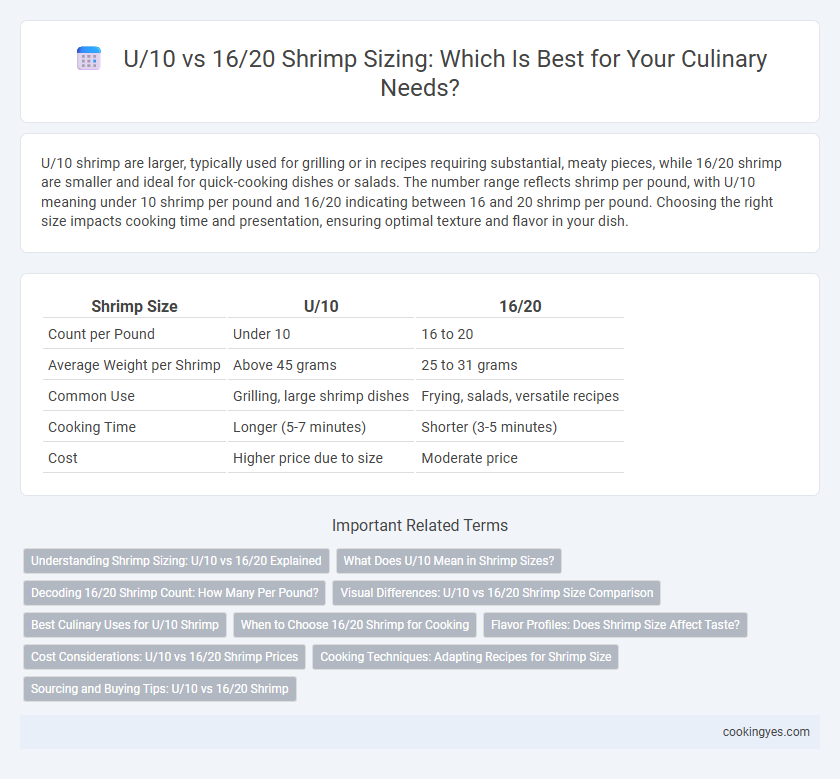U/10 shrimp are larger, typically used for grilling or in recipes requiring substantial, meaty pieces, while 16/20 shrimp are smaller and ideal for quick-cooking dishes or salads. The number range reflects shrimp per pound, with U/10 meaning under 10 shrimp per pound and 16/20 indicating between 16 and 20 shrimp per pound. Choosing the right size impacts cooking time and presentation, ensuring optimal texture and flavor in your dish.
Table of Comparison
| Shrimp Size | U/10 | 16/20 |
|---|---|---|
| Count per Pound | Under 10 | 16 to 20 |
| Average Weight per Shrimp | Above 45 grams | 25 to 31 grams |
| Common Use | Grilling, large shrimp dishes | Frying, salads, versatile recipes |
| Cooking Time | Longer (5-7 minutes) | Shorter (3-5 minutes) |
| Cost | Higher price due to size | Moderate price |
Understanding Shrimp Sizing: U/10 vs 16/20 Explained
Shrimp sizing is determined by the count per pound, with U/10 indicating fewer than 10 shrimp per pound, representing very large shrimp ideal for grilling or presentation. The 16/20 size means 16 to 20 shrimp per pound, a medium-large option commonly used in recipes requiring consistent cooking times and a balanced texture. Selecting between U/10 and 16/20 depends on recipe needs, portion size, and cooking methods, with U/10 preferred for steak-like servings and 16/20 for sauteing or frying.
What Does U/10 Mean in Shrimp Sizes?
U/10 shrimp size indicates shrimp with a count of 10 or fewer per pound, meaning each shrimp is larger and meatier compared to 16/20 size shrimp, which range from 16 to 20 shrimp per pound. U/10 shrimp are preferred in gourmet dishes due to their substantial size and rich texture, making them ideal for grilling or stuffing. Shrimp sizing impacts cooking time, presentation, and portion control, with U/10 offering a premium option for chefs and seafood enthusiasts.
Decoding 16/20 Shrimp Count: How Many Per Pound?
Understanding shrimp sizing is essential for cooking and purchasing decisions, with 16/20 shrimp meaning there are 16 to 20 shrimp per pound, often regarded as medium-large size. In contrast, U/10 shrimp are much larger, with fewer than 10 shrimp per pound, making them ideal for grilling or stuffing. The 16/20 count offers a balance of size and quantity, suitable for diverse recipes requiring moderate portion control and consistent cooking times.
Visual Differences: U/10 vs 16/20 Shrimp Size Comparison
U/10 shrimp, also known as jumbo shrimp, typically have fewer than 10 shrimp per pound and measure around 5 to 6 inches in length, making them significantly larger and meatier than 16/20 shrimp, which have 16 to 20 shrimp per pound and measure about 3 to 4 inches. Visually, U/10 shrimp exhibit a plumper, more robust body with a thicker shell, while 16/20 shrimp appear slimmer and are more compact. The size difference impacts presentation on plates and cooking times, with U/10 shrimp offering a more impressive, substantial look compared to the modest visual footprint of 16/20 shrimp.
Best Culinary Uses for U/10 Shrimp
U/10 shrimp, often labeled as extra jumbo, are ideal for grilling, stuffing, and skewering due to their substantial size and meatiness. Their larger size ensures a juicy, firm texture that holds up well in dishes like shrimp cocktails, seafood boils, and stuffed shrimp recipes. Compared to 16/20 shrimp, U/10 offers superior visual appeal and a more satisfying bite, making them perfect for gourmet presentations and hearty dishes.
When to Choose 16/20 Shrimp for Cooking
Choose 16/20 shrimp for recipes requiring quick cooking and uniform portion sizes, such as stir-fries and salads. Their medium size allows for even heat distribution without overcooking, preserving tenderness and flavor. This sizing balances meatiness and convenience, ideal for dishes where presentation and texture are key.
Flavor Profiles: Does Shrimp Size Affect Taste?
U/10 shrimp, being larger, offer a meatier texture and more pronounced oceanic flavor compared to smaller 16/20 shrimp, which tend to have a milder, sweeter taste with a firmer bite. The flavor intensity in U/10 shrimp is often preferred in grilling or broiling, where the robust taste stands out, while 16/20 shrimp are ideal for dishes requiring a delicate balance of flavors. Shrimp size influences not only taste but also cooking methods, as larger shrimp retain juiciness and flavor better under high heat.
Cost Considerations: U/10 vs 16/20 Shrimp Prices
U/10 shrimp are larger and typically command higher prices due to their size and meat yield, making them costlier per pound compared to 16/20 shrimp. The 16/20 size offers a more budget-friendly option with smaller, more uniform pieces that are suitable for recipes requiring consistent cooking times. Price differences between U/10 and 16/20 shrimp reflect factors like harvesting difficulty, market demand, and processing costs, with U/10 categorized as premium seafood.
Cooking Techniques: Adapting Recipes for Shrimp Size
U/10 shrimp, being larger, require longer cooking times and are ideal for grilling, roasting, or making shrimp skewers to maintain juiciness and flavor. In contrast, 16/20 shrimp cook quickly, making them perfect for sauteing, stir-frying, or adding to soups where rapid heat retains their texture without overcooking. Adjusting cooking methods according to shrimp size ensures optimal taste and prevents toughness or rubbery results.
Sourcing and Buying Tips: U/10 vs 16/20 Shrimp
When sourcing shrimp, U/10 shrimp are larger and typically used for grilling or skewering due to their substantial size, whereas 16/20 shrimp are medium-sized, ideal for boiling or frying. Buyers should consider the shrimp's intended preparation method to choose the appropriate size for texture and cooking time. Purchasing from reputable seafood suppliers ensures consistent sizing and quality, especially when ordering in bulk for restaurants or catering.
U/10 vs 16/20 for shrimp sizing Infographic

 cookingyes.com
cookingyes.com